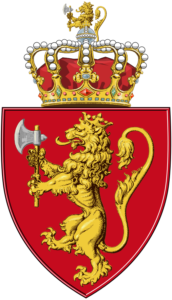orders of chivalry
Kingdom of norway
A brief history of norway
The first people arrived in Norway after 7,000 BC when rising temperatures after the end of the last ice age made the country habitable. The first Norwegians lived by hunting (elk, deer, seal and whales) and by fishing.
During the 9th century Vikings from Norway raided Scotland, England, Ireland and France. They even raided as far south as Spain, which at that time was in Muslim hands. But the Norwegians were not just raiders. They settled in the Hebrides (islands west of Scotland). And the Shetland and Orkney islands. Norwegians also settled the Isle of Man.
Harald Fairhair, son of Halvdan the Black, is the Viking chieftain credited with uniting the disparate warring tribes of the Viking into a nation. Harald’s greatest moment came in 872 at Hafrsfjord near Haugesund when he emerged victorious from one of world history’s few civil wars to be decided at sea. As a result of his victory, Norway had become a single country.
In 1066 Harald Hardrada tried to make himself king of England. However, he was killed at the battle of Stamford Bridge in Yorkshire. Harald’s army was defeated, ending Norway’s military involvement in England.
Despite Harald Hardrada’s death in 1066 his family ruled Norway until 1130. However after the death of his great-grandson, Sigurd the Crusader, Norway suffered a long series of civil wars.
Peace and stability returned to Norway under Haakon IV (1217-1263). During this time, Norway annexed Iceland and Greenland. Haakon was followed by his son Magnus the Lawmender. Magnus realized it was not feasible to defend the Hebrides against attack from Scotland, so he sold the Hebrides and the Isle of Man to Scotland.
In 1319 Norway was temporarily united with Sweden. King Erik of Norway was elected king of Sweden. The two kingdoms remained united until 1355. During that time, the plague struck Norway (1349-1350). It devastated the country and killed a large part of the population.
In 1307, Norway was joined to both Denmark and Sweden. Erik, nephew of Margaret I, queen of Denmark and Sweden, was recognized as heir apparent, and was crowned king of Norway, Sweden and Denmark. Sweden broke away in 1523 but Norway remained united with Denmark until 1814.
The Reformation reached Norway in the 1530’s. The Norwegians followed the Danes in accepting Lutheran doctrines.
Trade and commerce grew in Norway during the 16th, 17th and 18th centuries. Trade and commerce in Norway grew. In the 17th century Norway exported fish, timber, iron ore and copper. In the 18th century iron works were founded in southern Norway and they made all kinds of iron goods. The Norwegian merchant navy also grew substantially.
In 1813 Swedish forces invaded Denmark. In January 1814 Denmark was forced to surrender Norway to Sweden. However, some of the Norwegians rebelled against the move. Led by Crown Prince Christian Frederick, an assembly was convened on 17 May 1814 and drew up a constitution. Christian Frederick was elected king. However in July 1814 the Swedes invaded Norway. Christian Frederick stepped down and the Norwegians accepted the Swedish king. The Swedish king agreed to accept the constitution. Sweden controlled foreign affairs but Norway allowed a considerable amount of domestic autonomy.
Nationalism in Norway grew in the 19th century. In 1882 the Norwegian parliament, called the “Storting”, passed a law, which stated that members of the government must take part in debates in the Storting. The Storting passed the law three times; each being vetoed by the Swedish king Oscar II. Eventually the Norwegians decided to impeach the entire government. Afterwards the king was forced to relent, making Norway a parliamentary democracy.
The Swedish king formally gave up all claim to the Norwegian throne on 26 October 1905. On 13 November 1905, the Norwegians voted for a monarchy and Prince Carl of Denmark became King Haakon VII.
After independence the Norwegian economy prospered. Hydroelectricity flourished and in 1915 a ten-hour day was introduced.
During the First World War Norway remained neutral. However, as a result of unrestricted German submarine warfare, half of the Norwegian fleet was sunk. Over 2,000 Norwegian sailors lost their lives.
When the Second World War began in 1939, Norway remained neutral. This ended on 9 April 1940 when the Germans invade Norway. Narvik, Trondheim, Bergen and Oslo were quickly captured. Despite their brave resistance, the Norwegians were forced to capitulate on 10 June 1940. Norway was occupied for the rest of the war.
After 1945 Norway gave up the policy of neutrality and joined NATO in 1949.
Norway began to exploit vast reserves of oil and gas found in the North Se in the 1970’s. Meanwhile the number of jobs in traditional industries like agriculture and timber declined while the number of people employed in service industries increased.
In 1972 the Norwegians voted by 53% to 47% not to join the Common Market (forerunner of the EU). In 1994 the Norwegian voted against joining the EU in another referendum.
Today, Norway is one of the world’s most beautiful and prosperous countries. Important economic sectors include: hydro-electricity, fisheries, forestry, and minerals. Oil and gas production account for 20 percent of its economy. State revenues from petroleum are deposited in the world’s largest sovereign wealth fund. This prosperity helps the citizens of Norway enjoy a high standard of living.
the vikings
Vikings were the Norse people from southern Scandinavia (in present-day Denmark, Norway and Sweden) who from the late 8th to late 11th centuries raided and traded from their Northern European homelands across wide areas of Europe, and explored westwards to Iceland, Greenland, and Vinland. While the term “viking” historically referred to an activity undertaken by Norsemen, cognate with Normans, in modern English and other vernaculars, the term “viking” also commonly includes the inhabitants of Norse home communities during this period. This period of Nordic military, mercantile and demographic expansion had a profound impact on the early medieval history of Scandinavia, the British Isles, France, Estonia, Kievan Rus’ and Sicily.
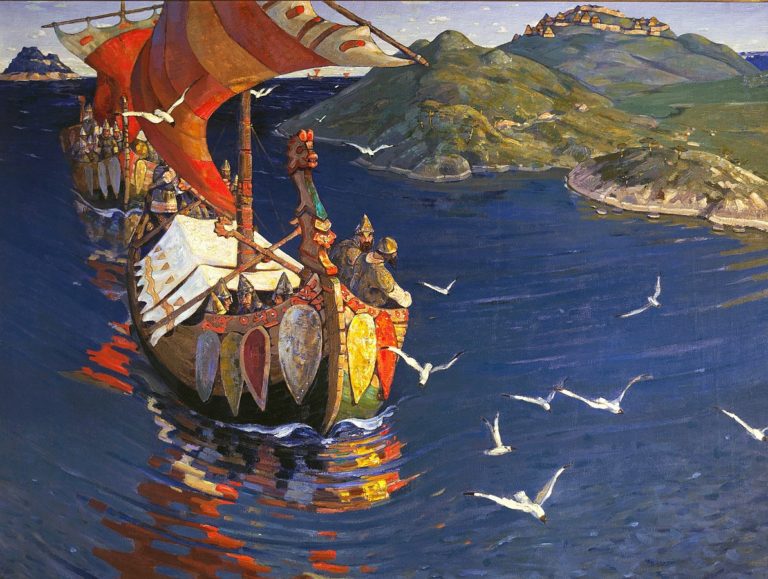
Guests from Overseas by Nicholas Roerich
Norwegian royal family
The Norwegian monarchy dates back more than one thousand years. Harald Fairhair, regarded as the first Norwegian king, united the petty kingships of Norway into a single realm in about 885. From the time of Harald Fairhair until the present day, Norway has had more than 60 named sovereigns.
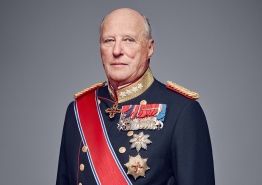
His Royal Highness Harald V
His Royal Highness Harald V, born 21 February 1937, is the King of Norway, having ascended the throne upon the death of his father King Olav V on 17 January 1991.
Harald was the third child and only son of King Olav V and Princess Märtha of Sweden. He was second in the line of succession at the time of his birth, behind his father. In 1940, as a result of the German occupation during World War II, the royal family went into exile. Harald spent part of his childhood in Sweden and the United States. He returned to Norway in 1945, and subsequently studied for periods at the University of Oslo, the Norwegian Military Academy and Balliol College, Oxford.
Following the death of his grandfather Haakon VII in 1957, Harald became crown prince as his father became king. A keen sportsman, he represented Norway in sailing at the 1964, 1968, and 1972 Olympic Games, and later became patron of World Sailing. Harald married Sonja Haraldsen in 1968, their relationship having initially being controversial due to her status as a commoner. The couple had two children, Märtha Louise and Haakon. Harald succeeded his father as king in 1991, with Haakon becoming his heir apparent.
orders of chivalry
Most nations throughout the world have an honors system, in which heads of state confer orders and medals on their countrymen and foreign nationals as a reward for their outstanding contribution to the greater good of society. Each year many individuals are recognized by His Majesty The King for their service to Norway and Norwegian society.
The royal Norwegian order of st. olav
The Royal Norwegian Order of Saint Olav is a Norwegian order of chivalry instituted by King Oscar I on 21 August 1847. It is named after King Olav II, known to posterity as St. Olav.
The order is used to reward individuals for remarkable accomplishments on behalf of the country and humanity. Since 1985, appointments to the order has only been conferred upon Norwegian citizens, though foreign heads of state and royalty may be appointed as a matter of courtesy.
The reigning monarch of Norway is the order’s Grand Master. The order consists of three grades, of which two are divided into two classes, and may be awarded for either civilian or military contributions, in descending order of distinction. The collar is awarded as a separate distinction of the Grand Cross to those recipients deemed exceptionally worthy.
Grand Cross – awarded to heads of state as a courtesy and in rare cases to individuals for merit; wears the badge on a collar (chain), plus the star on the left chest. If the collar is not worn the badge may be worn on a sash on the right shoulder;
Commander, which is divided into two classes: Commander with Star– wears the badge on a necklet, plus the star on the left chest;
Commander – wears the badge on a necklet;
Knight, which is divided into two classes:
Knight 1st Class – wears the badge on a ribbon on the left chest;
Knight – wears the badge on a ribbon on the left chest.
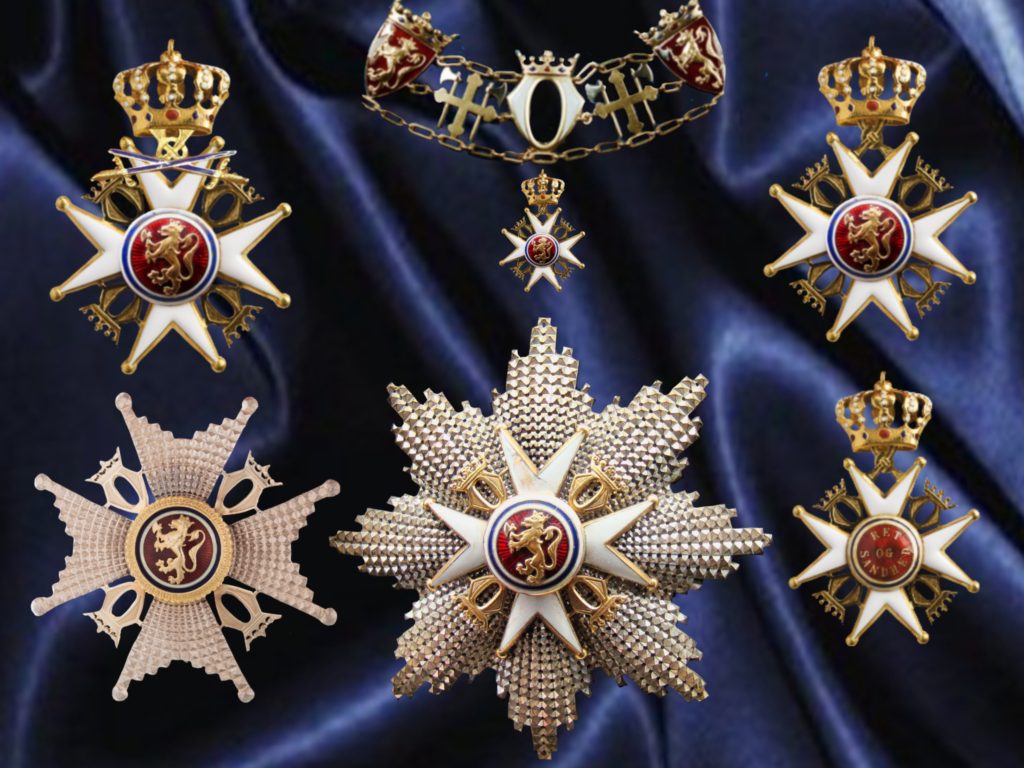
Order of St. Olav: Top left- Knight Commander, Top center-Grand Cross, Top right- Knight Commander (Dame), Bottom left-Commander’s Star, Bottom center-Grand Cross Star, Bottom left, Knight Officer
The Royal Norwegian Order of Merit
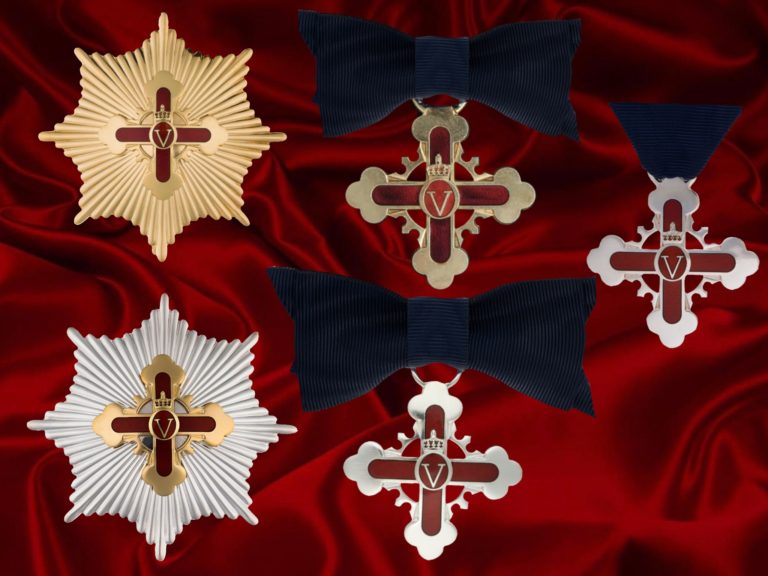
Order of Merit: Top left- Star of the Grand Cross, Top center-Grand Cross (Dame), Center right- Commanders Cross (when worn on neck) and Knight’s Cross when worn on breast, Bottom left-Commander’s cross, Bottom center-Knight’s cross (Dame)
The Royal Norwegian Order of Merit was instituted by King Olav V in 1985. It is awarded to foreigners, Norwegian citizens living abroad, Ministry of Foreign Affairs diplomats, foreign civil servants in Norway, and Norway’s honorary consuls for “outstanding service in the interests of Norway”. Its counterpart, the Royal Norwegian Order of St. Olav, is generally only awarded to Norwegian citizens living in Norway.
The reigning monarch, King Harald V, is the Grand Master of the Order. The order has five grades: Grand Cross, Commander (which is further subdivided into Commander with Star and Commander), and Knight (which is further subdivided into Knight 1st Class and Knight).
The Order is characterized by a ribbon of deep blue moiré. The Grand Cross is worn on a broad sash that hangs over the right shoulder. The Commander’s Cross is worn around the neck on ribbon of the Order. The Knight’s Cross is worn over the left breast on a ribbon. Women wear both the Commander’s Cross and the Knight’s Cross over the left breast on a ribbon of the Order that has been fashioned into a bow. Unlike the Order of St. Olav, the insignia of the Royal Norwegian Order of Merit are the property of the recipient.
Permission to produce this page was graciously provided by the Head of the Chancery of the Royal House of Norway.
One of the Northernmost countries of the world, beautiful Norway definitely has a lot to offer. Being recognized as the happiest country in the world, Norway fascinates travelers with its rich history, charming postcard-like cities, the surreal scenery of majestic cliffs and snow-capped mountains, towering crystal blue fjords, and the entrancing Northern Lights. Anyone interested in visiting Norway, is highly encouraged to visit one of the many sites promoting tourism to this unique and beautiful country.
Those interested in learning more about the Norwegian Royal Family or the Royal Norwegian chivalric orders are encouraged to visit the Royal House of Norway’s web page at www.royalcourt.no .
